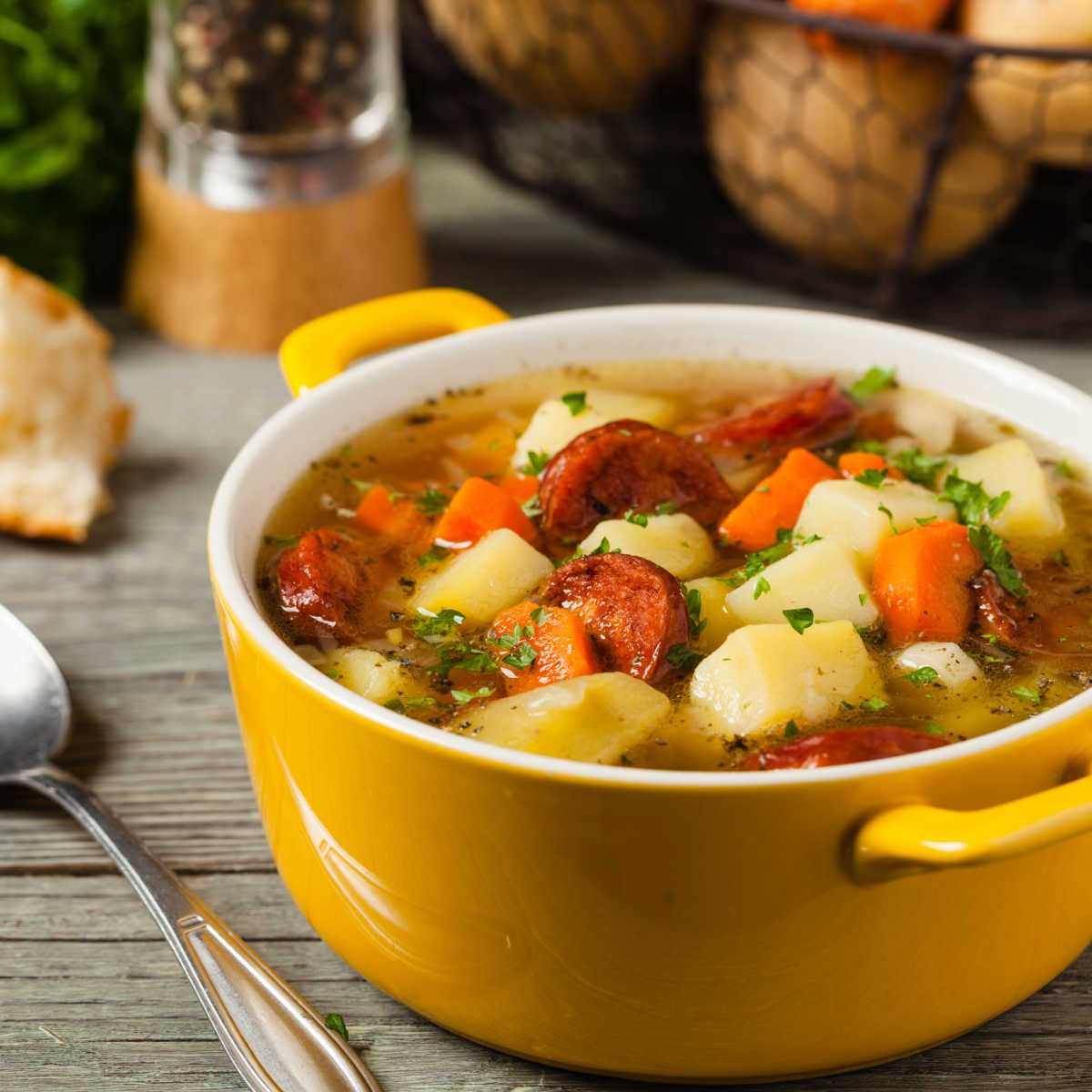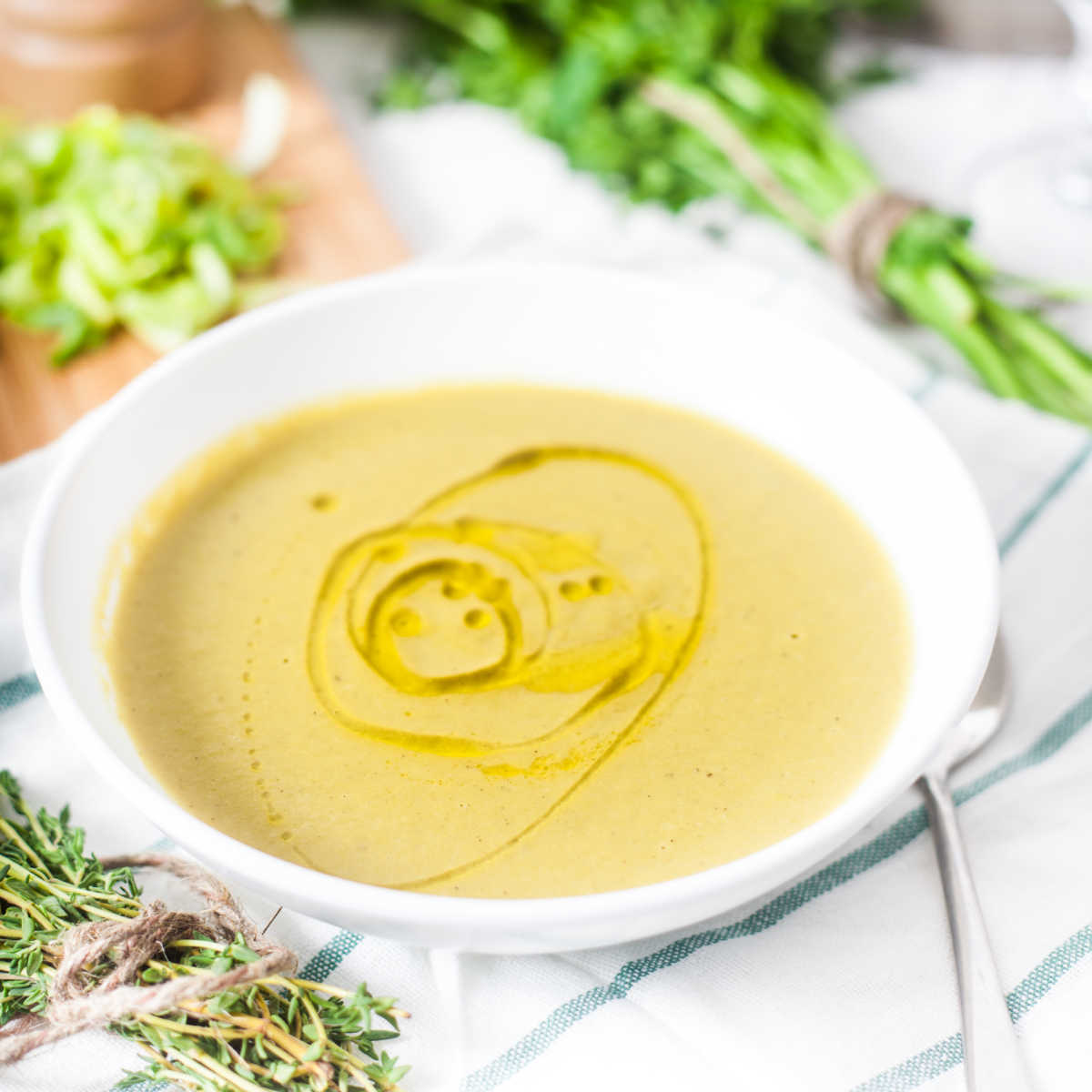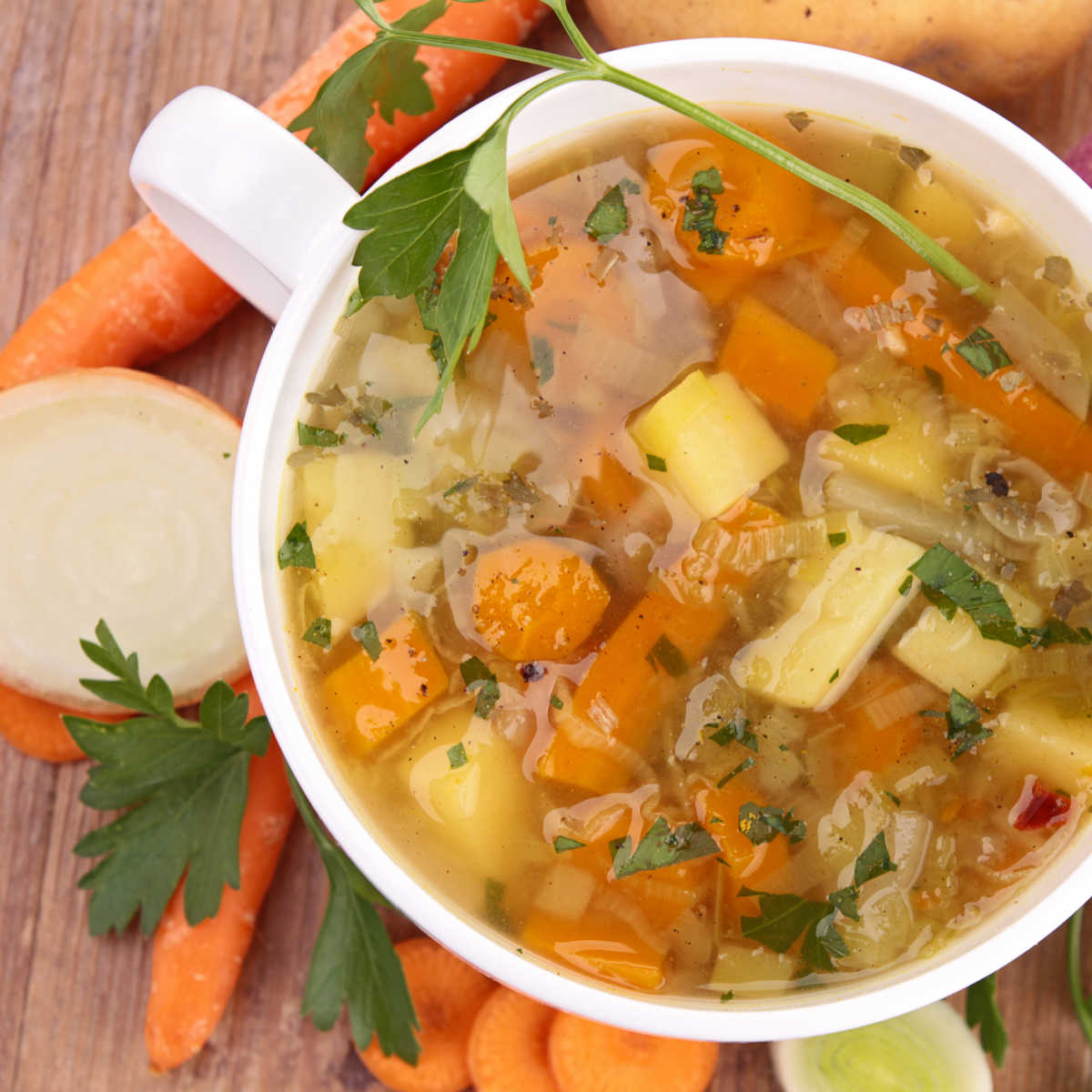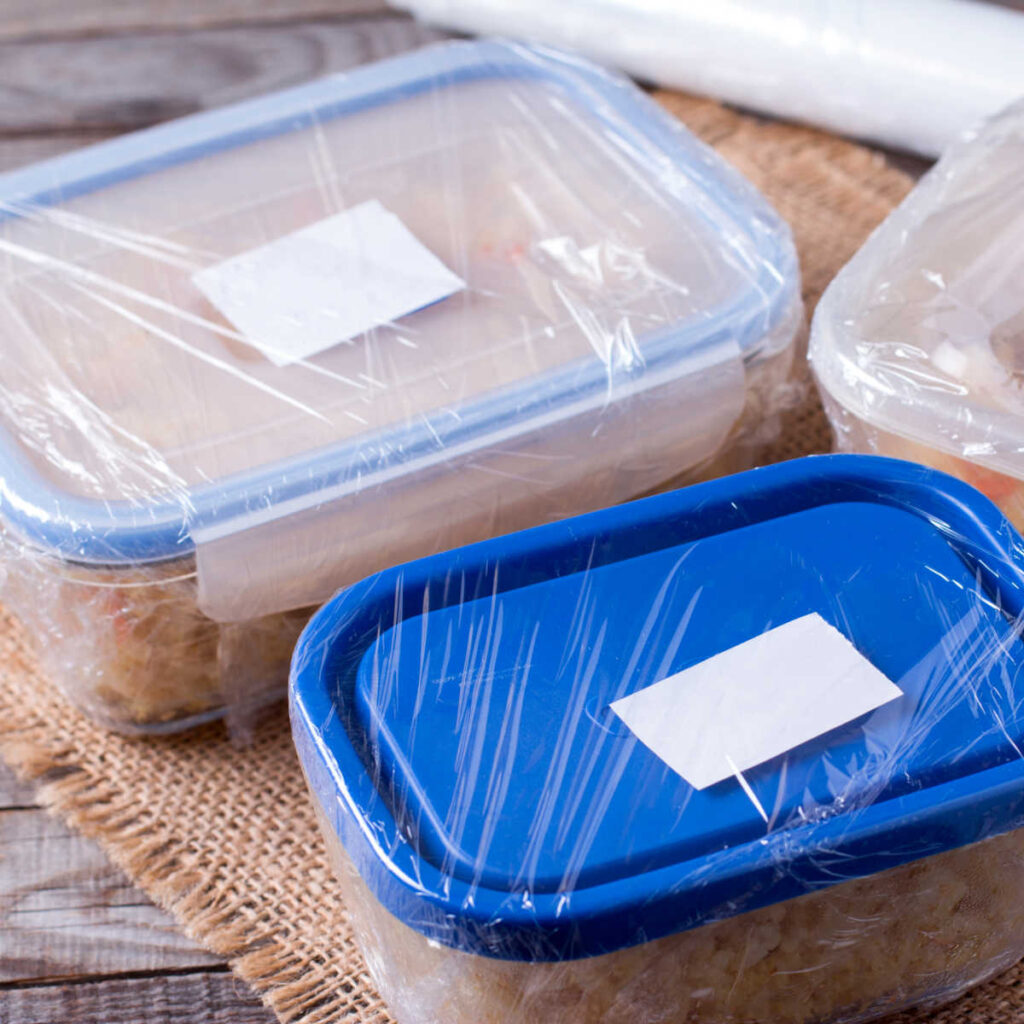Have you ever thought about freezing potato soup?
I love making potato soups, but sometimes I make way too much and I often freeze mine to keep for later. Recently I’ve started to double up my potato soup recipes and stock up my freezer at the same time. It’s great to always have a portion of potato soup ready when I’m hungry and don’t have the time to cook a big meal.
Can you freeze potato soup? The quick answer
Yes, you can freeze potato soup, but it depends on the ingredients you’ve used to make your potato soup.
Since it’s not that straightforward to know when it’s safe to freeze potato soup and when it’s not, I’ve decided to share with you my favourite tips on how to freeze and safely defrost most types of potato soups.

MY FAVOURITE POTATO SOUPS RECIPES
Why freeze potato soup?
Knowing that you can freeze potato soup is great because you can plan ahead and make a large batch of potato soup and then divide it into individual portions (or into 2 or 4 portions depending on your family), freeze it and then have your soup ready in next to no time!
When it’s not a good idea to freeze potato soup
If you’ve used any ingredient for your potato soup that was previously frozen, you shouldn’t re-freeze it again. Doing this increase the chances of any bacteria developing or the ingredient going off.
This particularly applies to ingredients that can go off easily, such as dairy milk, plant based milk, butter or cream, which are often used for creamy versions of potato soup.
It also depends on what proportion of the total soup amount is made up of the frozen ingredient.
For example, if you use previously frozen potatoes, which in most recipes form a substantial base of the potato soup, I really wouldn’t recommend freezing the soup afterwards again.
But if you’ve used a tablespoon of previously frozen herbs to make your potato soup, it should be pretty safe to re-freeze them as part of the soup.
MORE FOOD FREEZING TIPS
- Step by step guide on how to freeze gumbo >>
- Tried & tested tips on how to freeze gravy >>
- How best to freeze portobello mushrooms >>

What to expect when you freeze & defrost your potato soup
Depending on what type of soup you have, you might have a slightly softer version when you defrost your soup. Softer vegetables, such as potatoes, leeks or bread croutons can turn quite mushy when they are defrosted, especially if they are cut into small pieces.
I don’t think that’s something to be overly concerned about, but if you want to, you can always make it into a cream soup when you defrost it.
If you want to thicken your soup a little you can always use more potatoes. I often use leftover mashed potatoes that I keep in the fridge to add to my potato soup. The extra butter and milk in the creamed mashed potatoes is delicious in the re-heated soup.
MORE FOOD FREEZING TIPS
- Step by step guide on how to freeze courgettes >>
- How to freeze black pudding >>
- Step by step guide on how to freeze curry >>
What type of potato soup can you freeze?
Chunky potato soup – clear broth
This kind of potato soup freezes well and you shouldn’t have any problems when you defrost them.
Pureed Potato Soup – Cream of potato soup
You might notice a slight separation of the cream or dairy products from the rest of the soup. All you need to do is to mix the soup in or add a dash of extra cream or yoghurt.
Creamy potato soup with dairy products
The chances are that when you freeze soup with dairy, the dairy will separate from the rest of the soup when it’s defrosted and won’t look all that great. The freezing process could also change the soup texture a little too.
What I usually do with soups like these, is to puree them before I freeze them! I know they are more likely to end up like mush, so I actually puree them properly before!
If you notice any separation after you defrost your soup, just whisk or mix the soup as it is or add more cream or yoghurt to make the texture slightly thicker.
How long does potato soup last in the freezer
Providing that you’ve carefully frozen your soup in a freezer suitable container (and your freezer is in a good condition and the temperature doesn’t fluctuate), your potato soup should be fine in the freezer for 3-6 months.
Whilst I do like to freeze my potato soups, I usually try to eat them within 3 months, especially if they have any dairy in them (or meat). I don’t like to keep them in the freezer indefinitely.
If you are super organised, you should label our freezer containers with the date, so that you know when to take the soup out and rotate your frozen food stock a little. It’s easy to forget how long the containers are in the freezer especially if you can’t see exactly what they are and when they were frozen.
MORE FOOD FREEZING TIPS
- Tips on how to freeze potatoes for later use >>
- Step by step guide on how to freeze chicken eggs >>
- How to freeze pancakes >>

How to freeze potato soup
Make your potato soup first, using only fresh ingredients (ie. not ingredients that were previously frozen).
Leave the soup to cool down at room temperature.
Pour into a freezer suitable container with a lid or portion the soup into individual soup beakers.
Make sure that you leave a bit of space on the top of your soup (ie. don’t fill the whole container to the top) as the soup can expand slightly when it is frozen.
Always use a lid for your container to prevent your potato soup from spilling out, drying out or absorbing any flavour from the rest of the freezer.
Attach a label and write the soup name and today’s date to remind yourself.

What containers are best for freezing potato soup?
- Plastic beaker container with a lid for individual portions
- Soup container – plastic with a snap-on lid and suitable for freezer
- Large plastic container suitable for the freezer (and microwave if you wish)
- Strong plastic freezer bag with zip lock
MORE FOOD FREEZING TIPS
- Tips on how to freeze almond milk >>
- Tips on freezing lemon and other fruit curds >>
- Step by step guide on how to freeze jelly >>
How to defrost & heat up your potato soup
The easiest thing is to take out the frozen potato soup from the freezer the night before you need it and leave it to defrost in the fridge overnight (still in the closed container). Transfer to a suitable saucepan and heat it on a hob or heat it up in the microwave.
If you forget to take the soup out from the freezer the night before, you can also leave the soup out at room temperature to defrost, but do make sure that you heat it up and eat it straight away when it’s defrosted (as it can go off if you don’t do that – especially if you are using dairy products in your potato soup).
If you have a microwave, you can also just take out the frozen soup and providing it’s in a microwave suitable container, you can use the microwave’s ‘defrost setting’. When the soup is defrosted, increase the setting to high and heat up the soup for 2-3 minutes (depending on quantity).
If you don’t have a defrost setting, you can – very carefully – use the regular setting, but put it in the microwave for only 5-10 seconds at a time and try to stir or shake the container to distribute the heat before putting it back to the microwave.
MORE FOOD FREEZING TIPS
Quick way of defrosting and heating soup on a cooker
If you don’t have a microwave or don’t want to use one, you can also re-heat your soup on a hob or a cooker in a suitable saucepan. If you are in a hurry you can loosen out the frozen soup from the freezer container and place it frozen in the saucepan with a little bit of water.
Leave the saucepan or stock pot on a very low and use lid to keep the heat inside the pan. This will defrost the soup.
Once the soup has thawed, increase the heat and carry on heating for 5-7 minutes or until the soup is heated through. Because the soup was already cooked, it doesn’t have to boil, but you do still need to make sure that it’s hot enough to eat.








Leave a Reply